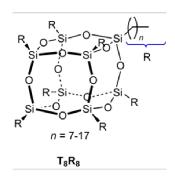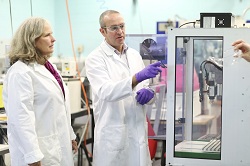Nanomaterials for Advanced Composites
The x-ray diffractometer analyses and obtains diffraction pattern data of materials using x-ray techniques to determine the structure of materials.
Research Challenge:
Nanomaterials are attracting significant interest in many fields owing to their interesting properties and, not least, for their mechanical benefits. One of the first areas of application is the use of nanoparticles as fillers (additives) in polymers, thus creating a nanocomposite with enhanced properties. Polyhedral Oligomeric Silsesquioxanes (POSS) molecules have attracted considerable interest over the last few decades in this respect.
 The POSS molecules investigated here (Figure 1) have a rigid inorganic (silicon-oxygen) caged core with functional side-group arms which can be functionalised for compatability with polymers and biomaterials. There have been recent investigations detailing the incorporation of POSS molecules as nanoparticles into polymers such as polyolefins, polyesters and polyamides and these are seen to bring about advantageous changes in physical and chemical properties of the polymer itself. For example, modulus strength, glass transition temperature, mechanical performance and thermal stability.
The POSS molecules investigated here (Figure 1) have a rigid inorganic (silicon-oxygen) caged core with functional side-group arms which can be functionalised for compatability with polymers and biomaterials. There have been recent investigations detailing the incorporation of POSS molecules as nanoparticles into polymers such as polyolefins, polyesters and polyamides and these are seen to bring about advantageous changes in physical and chemical properties of the polymer itself. For example, modulus strength, glass transition temperature, mechanical performance and thermal stability.
As a pre-cursor to production trials of POSS-polymer nanocomposites, WMG's Structural Materials research team studied the form and structure of POSS molecule cages with various side-group alkyl molecules that suspend off the main POSS chain.
Outcomes:
The study has established a direct link between the form and structure of the POSS and alkyl side-group. The alkyl side-group attached to the POSS cages have distinctive similar features. The study has established building blocks of commodity polymer materials. The compatability, processing and functional properties (mechanical strength, stiffness, etc.) of polymer nanocomposites is now under further investigation.
Being able to manipulate and design the functionality and properties of these molecules allows them to be fabricated into polymer nanocomposite components with improved physical and chemical properties. Scientific work is ongoing in WMG to evaluate the actual properties of such nanocomposites.

